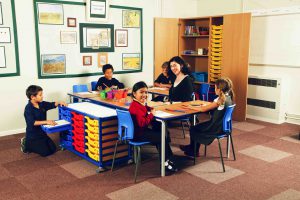Flexibility, mobility, adaptability
Richard Picking, Marketing Director of Gratnells, offers some thoughts about the future for school furniture
The healthy learning environment is a composite of elements, apart from the obvious bricks and mortar requirements teachers need bright, light and secure classrooms where colour abounds and learning resources are plentiful.
More than ever the creation of a child-centred environment relies on a mix of form and function – a balance between free creativity and good order. This is where good furniture design comes into its own to help the teaching process.

Flexibility, adaptability and mobility are the key attributes in helping to create the range of different work spaces needed to foster children’s creativity while ensuring an efficient system of storage and resource.
Affordable modular systems do exist now to create a range of layouts, adapting to the needs and size of the learner group and the subjects being taught. Designing a literacy corner, organising art groups or facilitating a science demonstration require very different arrangements. The good news is that colourful, practical, lightweight and mobile storage, display and racking units can integrate with standard room arrangements such as nested tables in groups to help deliver these alternatives.
Regimentation is rarely the answer and many schools are bold and experimental with layouts, using smaller groupings for practical work and circular or u-shaped layouts for more formal teaching. If this raises fears of a degree of chaos, integrating modular storage systems with the furniture will achieve that balance between good teaching and good order.
At primary and junior level, the accent is likely to be on the teacher’s ability to see the faces of every child and for the children to interact with each other as much as possible. As learners become more mature and their social interaction much more spontaneous then there is more of a premium on the furniture and systems supporting integral elements of the teaching mix, such as science, technology and advanced practical study. In arts too, the need for a disciplined system of storage and archiving is required, to keep creative materials and works in progress in pristine condition.
Trends now include the increasing functionality of system elements such as the development of trolleys which integrate with storage and stacking systems. These can literally be rolled out to support an art class with materials, a nature project with samples or a science group with equipment. Other more specialist applications have been developed, for example a unit which not only stores tablets and other hand held mobiles securely but acts as a charging station so that devices are always ready for use.
Providers are finding new ways to work in education, adapting and adopting the new technologies without abandoning time honoured requirements such as comfort and safety in pursuit of the optimum balance between a stimulating creative environment and an efficient, flexible learning infrastructure.
.

